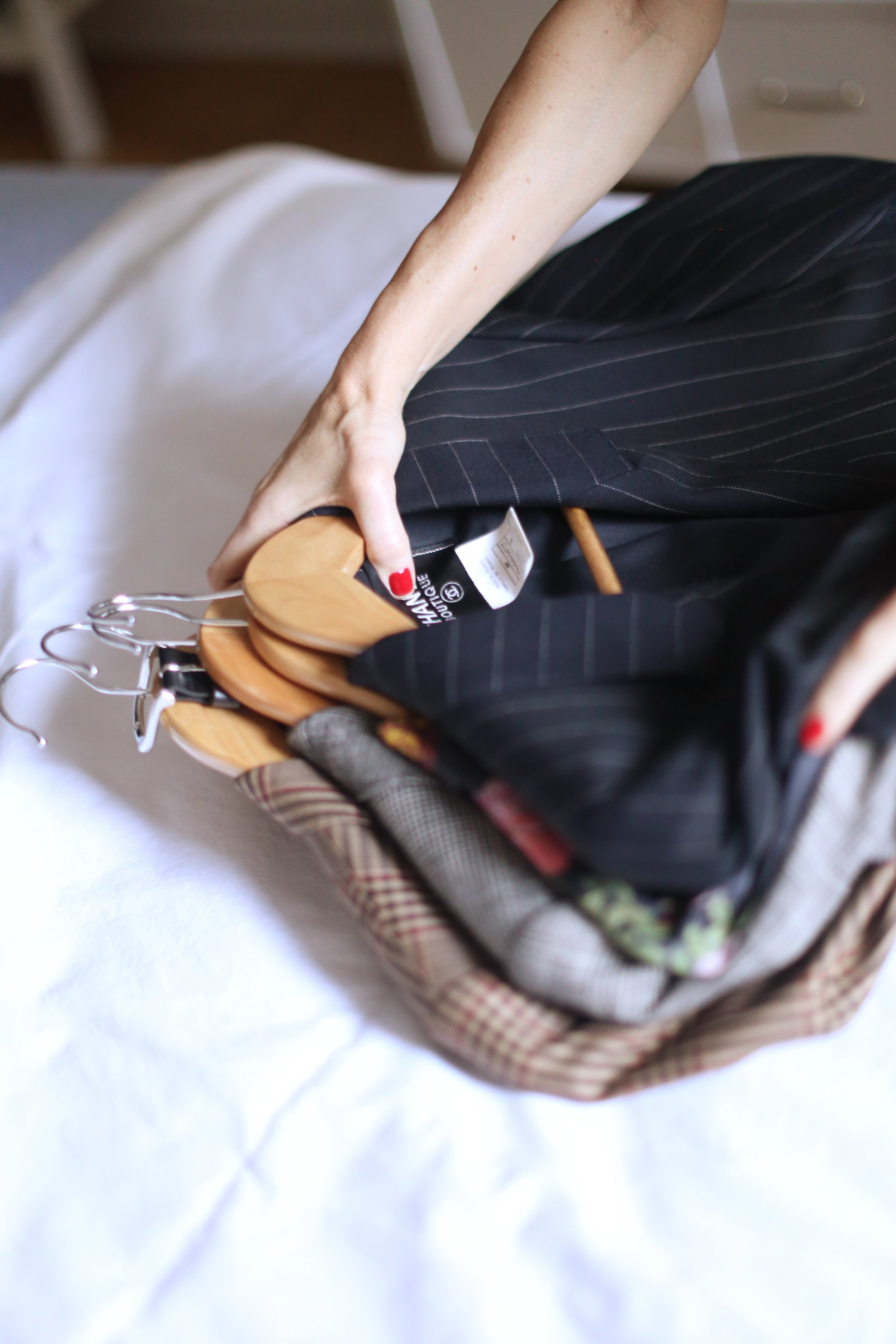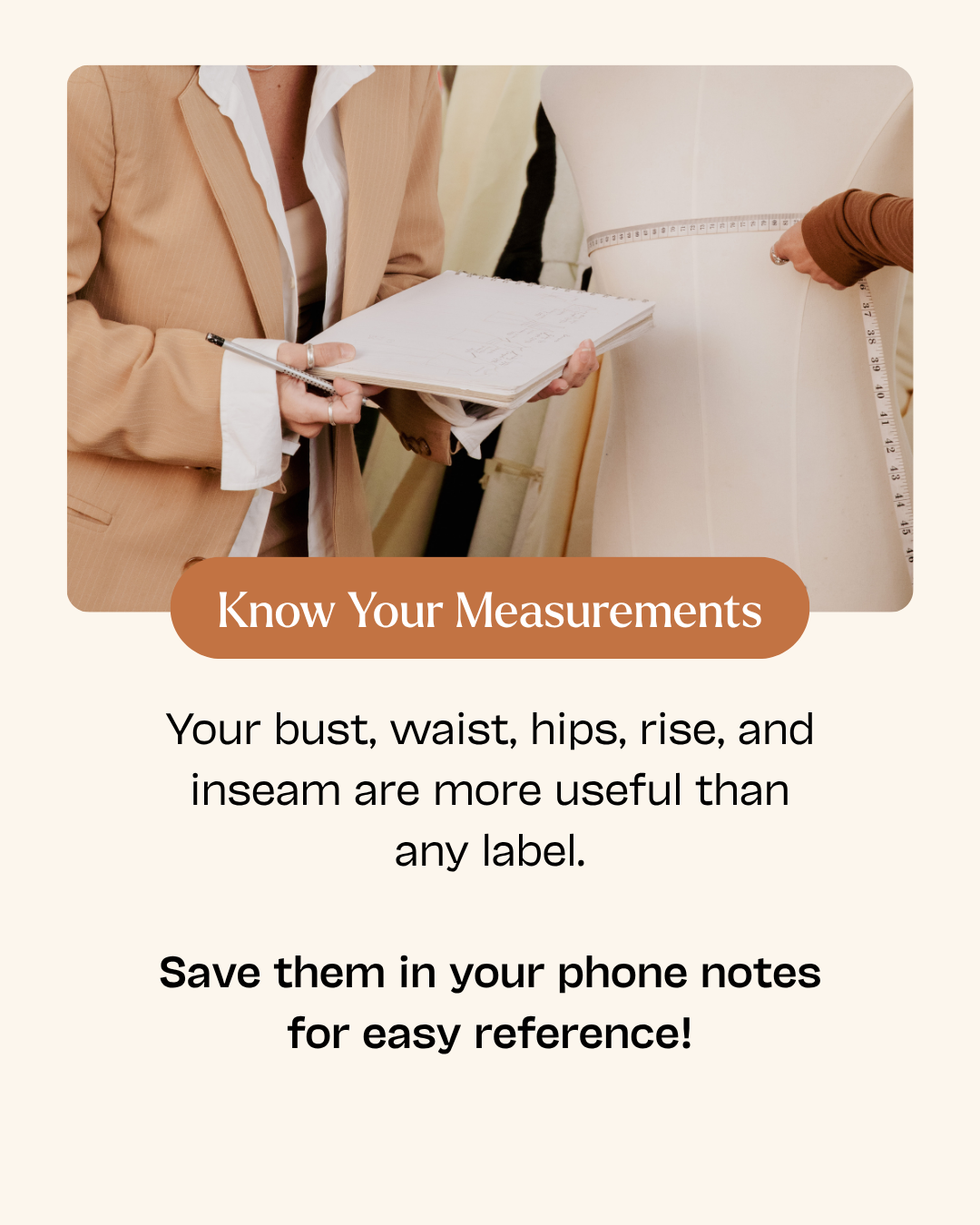Why Clothing Size Is Just a Number (Because There’s Literally No Standard Anyway)
Originally written in 2023, Updated July 2025
Natalie has shopped with clients at hundreds of different brands since 2010.
There is one thing that continues to frustrate her and something oft-lamented by clients: sizing is not even close to being consistent across brands.
Even now, within the same brand, size measurements can vary. It sucks, it’s annoying, and it has become a vehicle to perpetuate unhealthy obsessions with weight and body image issues.
Read on for Natalie’s research on the history of sizing, why it’s really just a number, and how you can start adjusting any negative relationship you have with size labels.
Let’s Be Real: Clothing Sizing Is a Mess
After 15 years of styling clients, I can confidently say there is no topic more frustrating—or more emotionally loaded—than clothing size.
The same client who beams in the fitting room can instantly deflate when they need to size up. I’ve seen people put back beautiful pieces that accomplish all of their fit goals just because the number on the tag wasn’t what they hoped. But here’s the truth: size is just a number, and it's one of the least reliable pieces of information in your wardrobe.
Let’s unpack why sizing is so inconsistent—and more importantly, how to navigate it in a healthier, more informed way.
The Backstory: How Did Clothing Sizing Get So Wild?
🧵 Clothing Sizes have Civil War Origins (Yes, Really)
Modern menswear sizing started in the Civil War era when soldiers’ body measurements were compiled to create ready-to-wear uniforms. That system of chest/waist/inseam sizing is still used today, but mostly for menswear (go figure).
👗 Women’s Sizing? Not So Simple.
In 1881, Charles Hecklinger developed pattern “blocks” for women's clothing, but the bust was a particular challenge. Even custom-made suits required up to 11 measurements.
A Quick History of U.S. Sizing Attempts in Women’s Fashion
1939: The USDA measured 15,000 women to try and create a national sizing system using bust size as the predictive anchor.
Why it failed: The participants were largely white, low-income volunteers—hardly representative of the full population—and the system assumed an hourglass figure as the standard. It ignored variations in torso length, shoulder width, hip proportion, and more. Still, this data laid the groundwork for decades of misguided attempts at standardization.
1958 : The government introduced a numeric sizing system ranging from sizes 8 to 42, with height indicators (T for tall, R for regular, S for short).
Why it failed: Although it was more structured than anything before, it still relied on outdated assumptions from the 1939 study and didn’t account for actual body shape diversity. It was quickly met with resistance from brands who found the rigid categories difficult to apply to real-world customers—and more importantly, to real-world sales.
1970: Revisions were made to the sizing chart in an effort to modernize it.
Why it failed: The updates were mostly cosmetic—minor tweaks to the existing measurements—without fundamentally rethinking how women’s bodies vary. The system still assumed uniform grading (the idea that all bodies scale evenly as sizes increase), which, spoiler alert: they don’t.
1983: The U.S. dropped the standard entirely.
Result: Brands were left to define their own sizing systems with no regulation. That’s when vanity sizing took off—brands realized they could label garments with smaller numbers to appeal to customers’ emotions. A size 12 became a 10. Then an 8. Then a 6. And eventually, we reached today’s chaos of double zeroes, vanity inflation, and total sizing inconsistency.
Vanity Sizing: Why Your “Size” Is a Moving Target
When brands realized that smaller size labels made shoppers feel better, vanity sizing took over.
A size 8 in 1980 might be labeled a 4—or even a 2—today, with no change in actual measurements.
Even insiders have admitted to shrinking the numbers just to flatter the customer.
Why Sizing Can Feel Personal (But Isn’t)
Our culture has trained us to see smaller sizes as “better,” but that’s marketing—not truth.
Here’s a personal example: I recently tried on pants from a brand I wore in high school. I’m 20 pounds heavier now, but wear two sizes smaller in that brand today. It’s not that I shrank. It’s that the tag did.
Understanding Why Clothing Sizes Vary Between Brands
No regulation on women’s sizing
Brands grade differently as sizes scale up/down
Target demographics skew size assumptions
Vanity sizing exploits psychology
Body diversity is far broader than most charts account for
A study called SizeUSA found that only 8% of women actually have hourglass figures—the foundation of most size charts. That's a problem.
The Emotional Effects of Vanity Sizing and Inaccurate Clothing Labels
Let’s normalize having multiple sizes in our closet. Most of us do—and that’s a good thing.
Still, I hear things like:
“I can’t wear that number.”
“Maybe I’ll try again after I lose weight.”
“I just want to be a size 6 again.”
But here’s the reframe: you are not the number on the tag. You’re the person choosing how you want to feel in your clothes.
Your Fit Strategy Starts Here: Our Personal Stylist Tips
Here’s how to shop smarter and start to ditch the shame spiral.
1. 📏 Know Your Real Measurements
Whether you're shopping online or in-store, knowing your measurements gives you power—not guesswork. You can either measure yourself or use a well-fitting item of clothing as a guide.
Here’s what measurements to jot down:
Bust – Measure around the fullest part of your chest while wearing your everyday bra.
Waist – Find your natural waist (usually the narrowest point) and measure snugly.
Hips – Measure around the widest part of your hips and seat, feet together.
Inseam & Outseam – Use a favorite pair of pants and note which heel height they work with.
Rise – Measure from the crotch seam to the top of the waistband (front rise).
Armpit-to-Armpit & Shoulder Width – For tailored tops, either measure yourself or lay a top flat and measure across.
Our Stylist Tip: Save your measurements in the Notes app on your phone. It’s one of the most useful tools you can carry into a fitting room—or keep handy while online shopping.
📏 Need a visual step-by-step? Try this guide: “How to Measure Your Waist, Hips, and Bust for Clothes”
2. 🛍️ Use Size Charts (But Don’t Obsess)
Yes, we just said sizing is inconsistent—but brand-specific size charts can still be incredibly helpful when used the right way. The key is to treat them as a starting point, not a personal verdict.
Size numbers can lie to you. Measurements don’t. That’s why pairing your own body measurements with a brand’s size chart is one of the smartest ways to avoid try-on fatigue or endless returns. Especially when shopping online.
Here’s how to use size charts strategically:
Compare your actual measurements—bust, waist, hips—to the brand’s chart. Look for charts that give garment measurements (not just body measurements) for the most accuracy.
Check for fit notes. Some brands call out if a garment runs large, small, or has stretch. Use that information to adjust up or down.
Pay attention to fabric. Woven fabrics (like poplin or denim) will fit more rigidly than knits or stretch blends. Use that to your advantage when between sizes.
Don’t let a number stop you. If your measurements align with a size you’re not “used to wearing,” remind yourself: you’re not buying the number—you’re buying the fit. Focus on how it will feel on your body, not what the tag says.
Stylist Tip: When in doubt, order two sizes if the return policy allows. Try them on at home, in your lighting, with your shoes. The right fit isn’t always the first one—but it’s always worth finding.
3. ✂️ Cut the Tags (If the Size Bothers You)
If the size label is messing with your head—even after you know the piece fits beautifully—go ahead and cut it out.
Sometimes we fall in love with how something looks and feels… until we glance at the number. That tiny tag can carry a lot of emotional weight, even when we know better.
So if that number is getting in the way of enjoying your clothes, remove it. You’re not being dramatic—you’re protecting your peace.
Stylist Tip: I’ve had clients enjoy a piece so much more once the tag was gone. The fit didn’t change, but their mindset did. Wear what fits. Wear what feels good. The number is optional.
4. 👯♀️ Try the Blind Try-On
This one’s a little outside the box—and incredibly freeing.
Ask a trusted friend, stylist, or sales associate to pull clothing options for you without showing you the size. Try them on with no tag-based expectations or hesitation. Choose what feels and looks best before peeking at the number.
We call this a "blind try-on,” and it’s a fantastic way to interrupt the mental game we play with size labels.
It’s also a great reminder that your body knows what feels right long before your brain chimes in with size-based noise.
5. 💬 Talk to Sales Associates
If you’re trying something on and it doesn’t work, say why—even briefly.
“This felt too snug in the shoulders.”
“I liked the shape, but it pulled at the waist.”
“I wish this had more length in the rise.”
Sales associates aren’t judging you. In fact, most are grateful when you share real fit feedback—because it helps them make better recommendations. They know which pieces run small, which stretch out, and which have that magic cut everyone keeps buying.
Bonus: If they get to know your preferences, they’ll often let you know when something just right for you comes in.
Online Shopping Sizing Tips
Shopping online can be convenient, but sizing can still feel like a gamble. These tips can help you stack the odds in your favor:
Order two sizes (if the return policy is forgiving).
If you’re between sizes or trying a new brand, order your best guess and the size up or down. Trying both at home—with your own mirror, shoes, and lighting—can make all the difference. Just be sure to check the store’s return window and process before you click “buy.”Read the reviews (the real ones are gold).
Customer reviews often include the details that product descriptions skip. Look for notes about whether a piece runs large or small, if it has stretch, how long it is on different heights, and how it fits different body types. Bonus points if reviewers include their own measurements.Compare model specs to your own.
Many sites now list the model’s height and the size they’re wearing. That gives you a reference point: if a midi dress looks knee-length on a 5’11” model and you’re 5’4”, you can expect a longer fit. Use these clues to imagine how the piece will look on your body.Stick with your tried-and-true brands.
Once you find a brand that consistently fits you well, bookmark it. You don’t have to reinvent the wheel with every purchase. Knowing which brands match your proportions (and your preferences) saves time, energy, and shipping fees.
Stylist Tip: Add to that note on your phone listing your “best size” in each of your go-to brands, or join our BU Style Circle to get access to your own Virtual Closet that can track what you own in your closet and the sizing. That way, you’re not guessing every time you shop—and you’ll know when to confidently skip the return roulette.
What Your Closet Is Trying to Tell You
Take a peek inside your closet. If you see a range of sizes on those tags—4s, 8s, mediums, larges, maybe even a men’s jacket or two—you’re doing it right.
That variety doesn’t mean your body is “confusing” or inconsistent. It means you’re dressing for your real body, not some rigid, outdated sizing standard that was never designed with your uniqueness in mind.
Bodies aren’t static—they move, change, cycle, grow, and shift over time. Hormones, stress, travel, joy, sleep, strength training, aging—it all plays a role. Expecting your body to stay one size forever is like expecting the weather to be 72 and sunny every day. That’s just not how being human works.
When you let your clothes adjust to you—instead of forcing yourself to adjust to your clothes—you make space for freedom, ease, and joy in how you get dressed.
Your closet should serve you through seasons, both literal and personal. So if you’ve outgrown something, or sized up, or found a brand that runs bigger or smaller than the last? That’s not a problem. That’s personal style in motion.
Rethinking Clothing Sizes: A Mindset Shift for More Confident Dressing
Would you refuse to size up in shoes because your foot changed slightly?
Would you skip buying a ring you love just because you wear a 7 instead of a 6?
Probably not. And yet with clothing, many of us hesitate to go up a size—even when it’s the key to comfort, confidence, and a better fit.
It’s time to stop giving so much emotional weight to a system that was never consistent in the first place. Clothing sizes aren’t standardized, and they were never meant to be a measure of your worth, health, or success.
The truth is: size is just a data point. It’s not a reflection of your value.
The number on the label is there to help guide you toward the best fit—it’s not there to define you. If it’s helpful, use it. If it’s harmful, cut it out (literally or emotionally).
Your identity is not a size tag. Your identity is the way you move through the world, the way you light up in what you wear, the way you express yourself when the clothes feel right.
So let’s shift the goal. Instead of aiming for a smaller number, aim for a better experience. Aim for clothing that fits the body you have today and honors how you want to feel in it.
Because you deserve to wear what supports you—not what shrinks you.
Stop Letting Clothing Sizes Define Your Confidence
Let’s be clear: there’s no prize for wearing the lowest size in the room.
No one’s handing out gold stars for squeezing into a number that doesn’t fit—physically or emotionally. But there is real joy in feeling like yourself in clothes that move with your body and support your life.
When you stop chasing the label and start focusing on the fit, everything shifts. You start dressing for where you are now, not where you “should” be. You build a closet around your actual life, not the version you were told you had to earn.
So if a number on a tag is holding you back—if it’s keeping you from trying something, loving something, or even feeling good about yourself in the fitting room—it might be time to cut it out. Literally. Emotionally. Energetically.
Let size be a tool, not a test. Use it to narrow the range, then rely on your body, your eye, and your intuition to choose what works best.
Your style isn’t found in the size. It’s found in how you show up, feel, and move when you’re wearing what aligns with you.
Make size un-matter because your clothes should reflect your life, not restrict it.
Want More Support?
Explore BU Style Services
Join the BU Style Circle for resources, shopping guides, and community support
Listen to the related podcast episode: Wear Who You Are, “Clothing Sizing Is BULLS$!T” on Apple, Spotify, or wherever you get your podcasts.







